Bustling with year-round outdoor activities, New Hampshire draws thousands of visitors each year eager to enjoy the natural wonders found across the state. In the fall, they gasp at the beauty of the foliage on hikes or drives through the White Mountains, and when spring arrives, they taste sweet maple syrup made from those same trees. Winter brings the heaviest snowfall seen anywhere in the country, creating the perfect conditions for skiing and snowboarding. When the snow finally melts, filling the lakes with fresh water, everyone starts counting down the days to summer vacation, dreaming of that first day swimming in Lake Winnipesaukee.
The history of New Hampshire runs deeper than the granite just below the surface. As one of the original 13 colonies, some of the oldest colleges and institutions began in this small state. After gaining independence from England, the people of the state began to realise the power of their voices, while exclaiming ‘Live Free or Die’. Over a century later, they formed the first presidential primary, shaping the nation’s leadership right up to today. There’s a reason why so many people travel to New Hampshire each year. Let’s take a closer look at what New Hampshire is famous for.
Contents
- What Is New Hampshire Known For?
- Top Tours
- 1- Mt. Washington
- 2- Mt. Washington Cog Railway
- 3- Dartmouth College
- 4- Skiing
- 5- Lake Winnipesaukee
- 6- Fall Foliage
- 7- Maple Syrup
- 8- The Seacoast
- 9- Flume Gorge
- 10- Presidential Primary Elections
- 11- Kancamagus Highway
- 12- Covered Bridges
- 13- The Motto “Live Free Or Die”
- 14- Old Man On The Mountain
- 15- Granite
What Is New Hampshire Known For?
Top Tours
- Kancamagus Scenic Highway Self-Driving Audio Tour – see fall foliage, gorgeous views, mountains and learn local legends.
- Portsmouth: Self-Guided Haunted Walking Audio Tour – discover spooky places at your own pace.
- Explore the Islands & Harbor Guided Bike Tour – a two-hour tour.
1- Mt. Washington
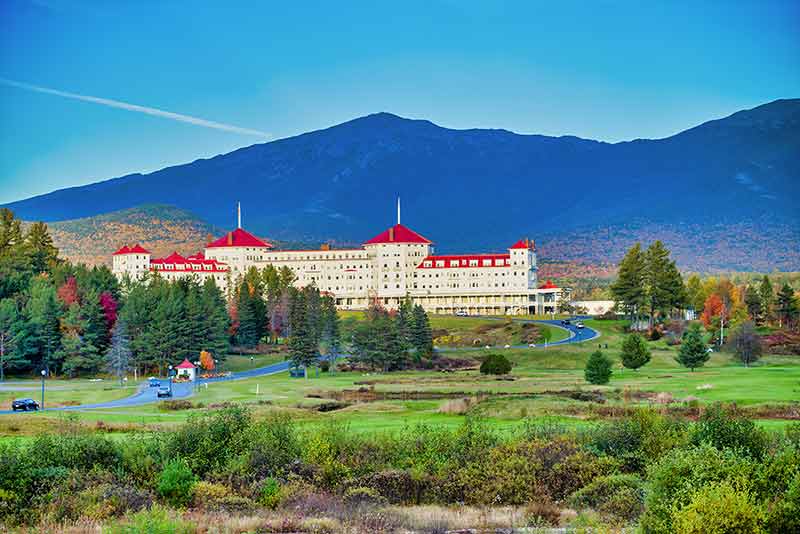
Known for the most extreme weather in the world, with recorded wind speeds of 371 km per hour, Mt. Washington reigns high above the White Mountains at an elevation of 1,917 metres.
As the tallest mountain in the northeast and the highest peak in the Presidential Range of New Hampshire, Mt. Washington challenges climbers from around the world to reach the summit.
In the winter, extreme skiers and snowboarders climb to the top of Tuckerman’s Ravine to enjoy the thrill of blasting down one of the steepest slopes in the state.
Besides hiking, there are other ways to reach the top of Mt. Washington. In addition to the world-famous Mt. Washington Cog Railway, the Mt. Washington Auto Road has led tourists to the peak since 1861, at first with horse-drawn carriages.
The Mt. Washington Auto Road is America’s oldest and continuously operating tourist attraction and also hosts exciting uphill races for runners, bicyclists, and rally car drivers.
2- Mt. Washington Cog Railway
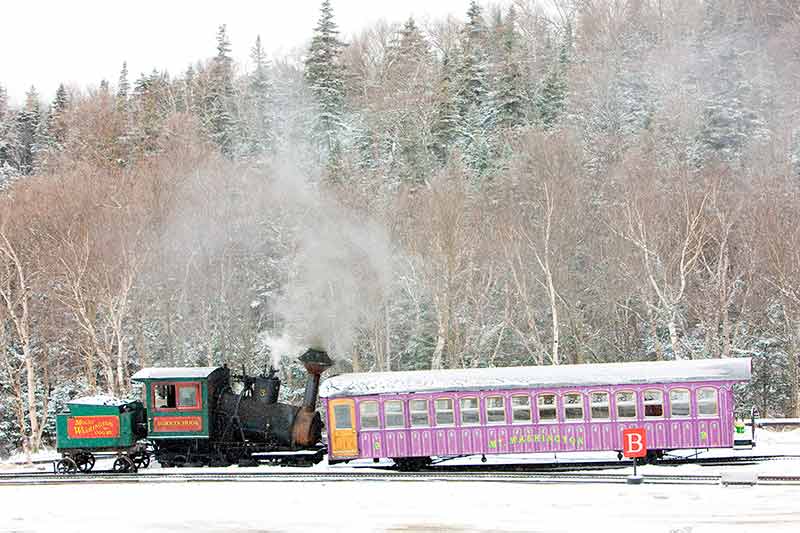
As the first train ever to climb a mountain, the Mt. Washington Cog Railway is a true marvel of modern engineering, able to climb grades of 37%, making it the second steepest rail line in the world.
Completed in 1869, the steam train known as the ‘Cog’ uses a drive wheel with 19 cogs, gripping the teeth attached in the centre of the rail to slowly carry passengers to the summit.
On the way back down, the same cogwheel acts as a braking mechanism to slow its descent.
Nearly 5 million people have made their way to the summit using the Mt. Washington Cog Railway.
The journey from the station to the summit of Mt. Washington takes about 1 hour and 10 minutes, travelling 5 km up the western side of the mountain.
In 2008, biodiesel locomotives were introduced to the track, shortening the travel time to a mere 36 minutes.
3- Dartmouth College
Tucked away in the quaint little town of Hanover, Dartmouth College’s reputation for the highest standard of education spans over two centuries, just a few short years before American independence.
Founded by Eleazar Wheelock in 1769 as a missionary school for young Native Americans and white students, it later became one of the most prestigious colleges in the country in the early 20th century.
Dartmouth is one of only nine colleges founded before the American Revolution, and one of eight ‘Ivy League’ schools in the United States, known for the highest academic standards, and rigorous student admissions, with less than 10% of applicants being accepted annually.
The college’s liberal arts program provides education in 40 different academic departments, with graduate studies in medicine, business, and engineering.
Dartmouth College also has close ties with the nearby Dartmouth-Hitchcock Medical Center, which was formed as a small hospital in the early days of the medical program at the college.
4- Skiing
A state with one of the highest snowfalls, New Hampshire’s skiing and snowboarding conditions are nothing short of superb every winter.
With 188 ha (465 acres) of skiing trails, Bretton Woods wins the prize for the largest ski area in New Hampshire, while Cannon Mt. in the Franconia Notch offers the most challenging trails.
For those looking for a family-fun option, Loon Mountain and Mt. Sunapee offer trails for every level of ability.
February brings the heaviest amounts of snowfall to the state, adding loads of powder to the slopes, especially at higher elevations.
There are 28 great ski resorts in New Hampshire and magnificent mountain scenery to enjoy by going cross-country skiing.
At the foot of Mt. Washington, the Bretton Woods Nordic Center offers a 100 km network of trails that wanders through the forests, and across mountain streams.
Cross-country skiers can also explore the open farmland in Jackson, a classic New Hampshire ski village.
5- Lake Winnipesaukee
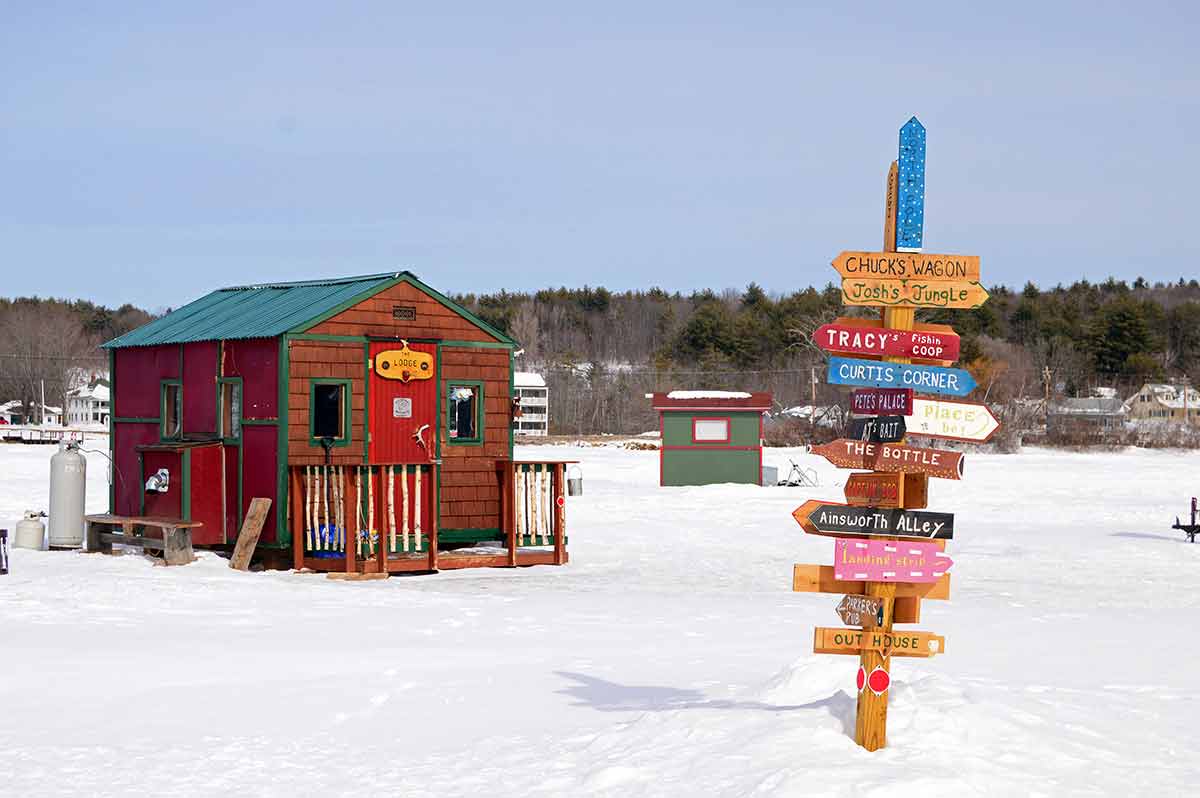
When the summer heat waves sweep across New Hampshire, locals and tourists swarm the lakes region eager to cool off, with the majority heading to Lake Winnipesaukee, the largest in the state.
Stretching 33 km long and 14 km wide, Winnipesaukee provides more than enough space for everyone to enjoy their favourite watersport activities, especially boating.
Weirs Beach in Laconia attracts the largest crowds, for its stunning beaches, and scenic lake cruises aboard the MS Mount Washington.
With hundreds of small islands and coves, it’s also a paradise for fishing and canoeing.
When the sun goes down, there’s still more to do. There are live concerts at the BankNH Pavillion, famous arcades at Funspot, and plenty of outlet stores and restaurants nearby.
For more cool stuff in New Hampshire, check out:
- 20 New Hampshire State Parks
- 16 New Hampshire Beaches
- New Hampshire National Parks
- 20 Landmarks in New Hampshire
- 20 Towns and Cities in New Hampshire
- 20 Things To Do In Portsmouth NH
- 20 Things To Do In Concord NH
- 20 Things To Do In Nashua NH
- 20 Things To Do In Manchester NH
- 20 Things To Do In Lincoln NH
- 15 Things New Hampshire Is Famous For
6- Fall Foliage
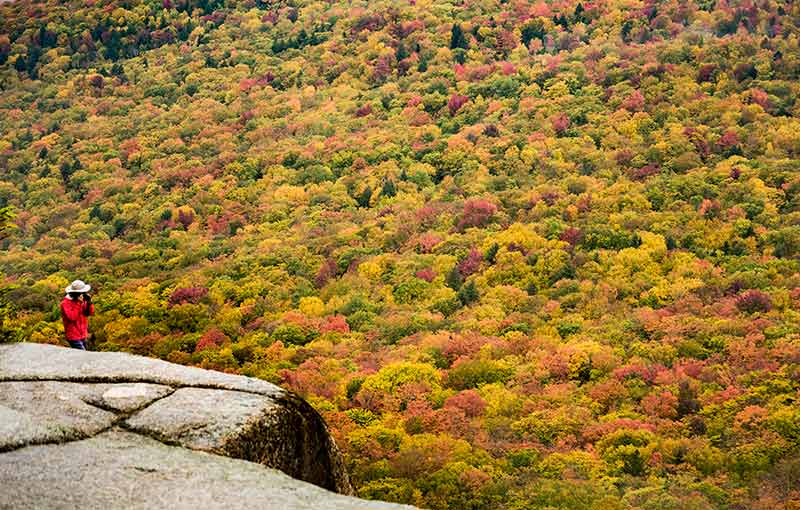
With over 80% of New Hampshire covered in forests, it’s no wonder why thousands flood the state in mid-September and early October, eager to catch a glimpse of the radiant fall foliage colours.
The unique diversity of trees found in the state adds to the vibrant hues of red, gold, orange, and yellow. Forests with maple, willow, oak, beech, and birch trees are known to provide the most brilliant colours.
Timing and location are the keys to this unforgettable experience. The Great North Woods and the White Mountain regions peak in late September, while the Monadnock Region tends to peak in the early weeks of October.
Driving across the varied terrain of New Hampshire adds another dimension of enjoyment. On the Kancamagus Highway, cars pass under the canopy of the trees in the valleys and then ascend to mountain tops where it’s possible to see the stunning colours for hundreds of miles.
7- Maple Syrup

From late February to early April, New Hampshire’s sugaring season kicks into high gear when over 300 sugarhouses throughout the state start boiling down the sap from maple trees, creating maple syrup and other sugary treats.
Although New Hampshire does not produce as much maple syrup as its sister state, Vermont, it’s still a household staple on nearly every breakfast table in the state.
To make this delicious pancake topping, farmers tap the maple trees with a spout, and attach a bucket to collect the sap. As the trees thaw after the winter, the sap begins to flow out.
From there, the sap is transported to the sugarhouse to be boiled down into a thicker, sugar-rich amber-coloured syrup. It takes around 40 gallons of clear maple sap to create one gallon of maple syrup.
Maple syrup comes in a variety of grades, with the golden and amber-coloured ones offering a more delicate and rich taste, and the darker ones, featuring a more robust flavour.
- Made in Lancaster
- Comes in traditional, plastic jug
- Dark Amber
- Fuller’s Sugarhouse is a family owned and operated business…
8- The Seacoast
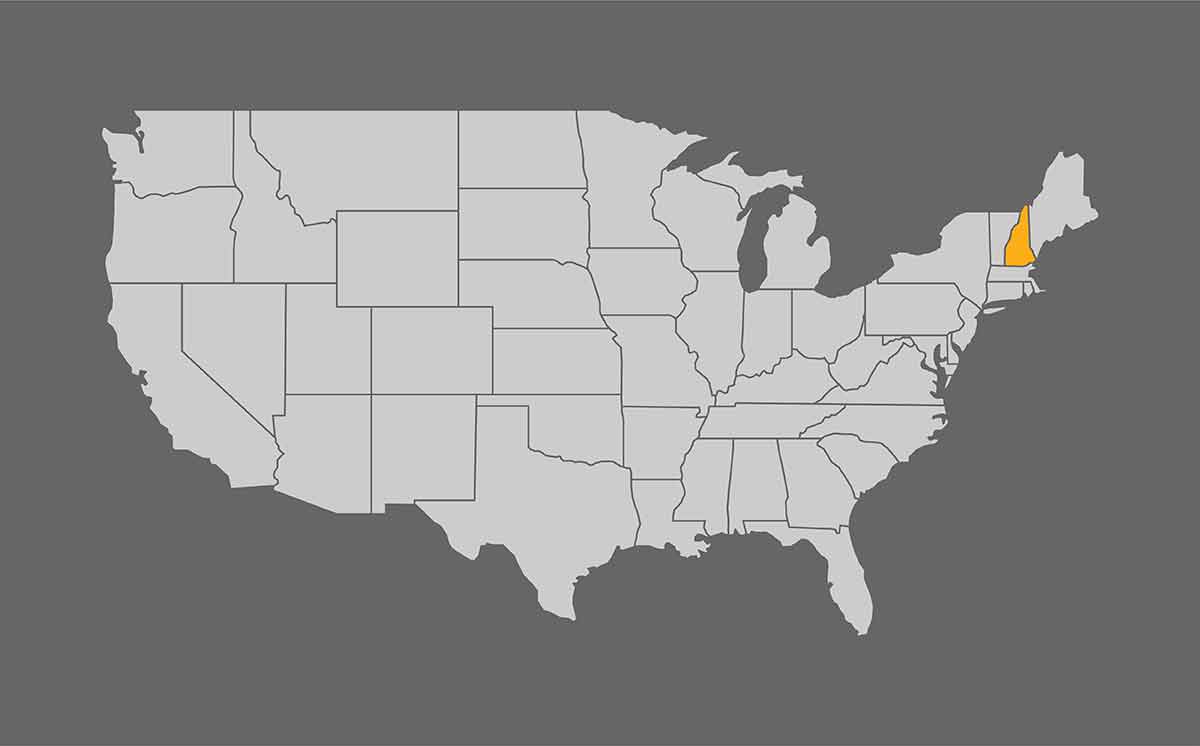
On a small 30 km stretch of land between Maine and Massachusetts, the seacoast area in New Hampshire offers a unique look into the state’s early history and plenty of summertime fun.
With the shortest coastline of any U.S. state, you can expect packed crowds on New Hampshire’s beaches when summer arrives.
Most visitors gather around Hampton Beach, where the white sands are backed by a boardwalk with live music, seafood restaurants, hotels, and shops.
Those looking for a more tranquil setting to soak up the sun, head north to the Rye and Wallis Sands Beaches.
In Portsmouth, the Strawberry Banke Museum located on the site of the original settlement from 1630, provides insight into New Hampshire’s 400-year history.
Nature lovers will also feel right at home wandering through the beautiful flowers in Prescott Park, or the Fuller Gardens in North Hampton.
9- Flume Gorge
At the base of Mt. Liberty in Franconia Notch State Park, nature managed to carve a 240-metre gorge into the granite hillside forming what locals call ‘The Flume’.
Around the Jurassic Period, granite was pushed up through the earth’s surface along with basalt forming a large rock outcropping.
Over 200 million years of erosion wore away the softer basalt leaving behind the exposed granite forming the gorge.
Discovered by a landowner in 1808, the Flume Gorge contains sheer granite walls that reach up to 90 feet tall in some places.
As the river descends through this large chasm, it creates several stunning waterfalls.
Later on, boardwalks were built to allow for easier exploration of the gorge, crossing the river at several points and taking you to the best vantage points of the waterfalls on a 3-km loop trail.
In the warmer months, the gorge comes alive with flowers and other flora, fed by the melting snow from high above.
10- Presidential Primary Elections
As the first-in-the-nation to vote in presidential primary elections every four years, New Hampshire plays a pivotal role when it comes time for the country to choose the next president.
Eager candidates can be seen roaming the state in the months leading up to the primary, greeting residents at town hall events, walking in parades, and giving small stump speeches as they go.
The citizens of New Hampshire are proud of having their voices heard across the nation. The tradition of being the first state to vote in the presidential primary goes back to 1920.
For decades, the majority of the winners in the primary in New Hampshire have gone on to become their party nominees, and even a few won the general election.
Since 1992, New Hampshire has been considered a swing state when it comes to selecting candidates for national office, despite voting primarily for Republicans for most of the 19th and 20th centuries.
11- Kancamagus Highway
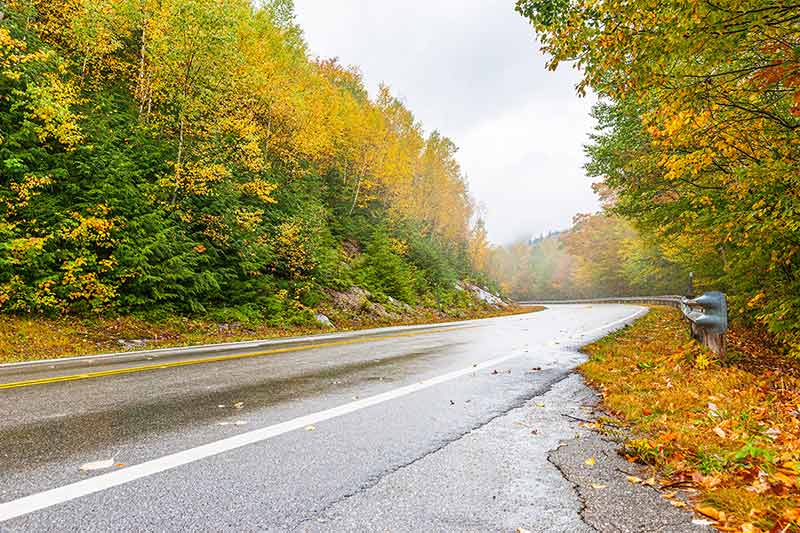
Stretching 55 km from Lincoln to Conway, the Kancamagus Highway winds gracefully through ridgelines of the White Mountain National Forest while offering spectacular viewpoints at every stop along the way.
Known as the ‘Kanc’ by the locals, the highway runs adjacent to the Swift River and in the summertime, the crowds cool off in their favourite swimming holes around the Lower Falls.
The Kancamagus Highway also allows access to loads of scenic hiking trails, many of which lead you to stunning waterfalls, such as Sabbaday Falls and Champney Falls.
In September and October, thousands of leaf peepers journey across the highway in awe of the golden fall foliage colours, from viewpoints that span over hundreds of miles.
From start to finish, there are no gas stations, hotels, restaurants, or businesses. The Kancamagus fully immerses travellers in nature’s beauty and offers the opportunity to enjoy the wilderness a while longer with six campgrounds right off the highway.
12- Covered Bridges
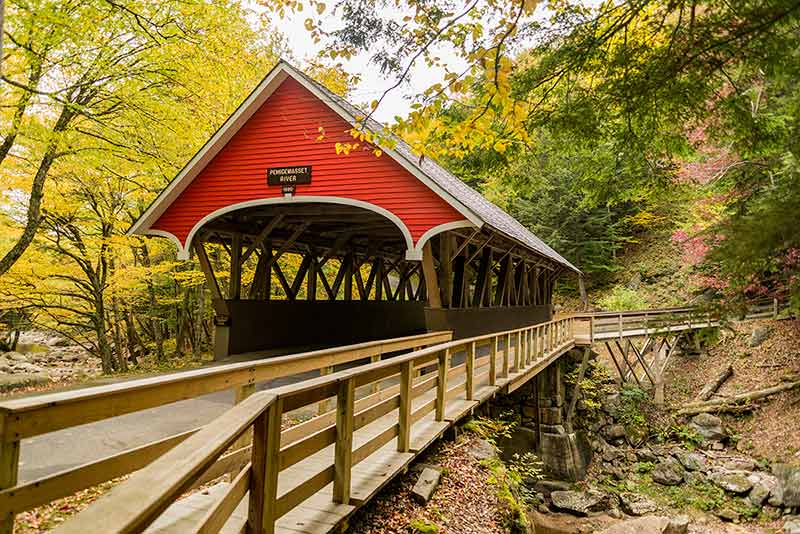
Covered bridges can be found throughout New Hampshire, built in a variety of designs to allow passage of horses, cars, foot traffic and even trains.
In New Hampshire’s early days, bridges were constructed from spruce and white pine for flexibility and strength, but due to the abundance of rain and snow in the state, they were highly susceptible to decay.
To protect the wooden trusses and decks, builders in the early 1800s began covering the bridges with siding and roofs, creating one of New Hampshire’s most iconic structures.
Covering the wooden bridges also enabled easier passage for horses, by eliminating icy or wet surfaces, and reducing the risk of them being spooked from fear of heights.
Officially, there are 58 historic covered bridges in the state and the longest is the Cornish-Windsor Covered Bridge, stretching an astounding 137 metres across the Connecticut River, connecting New Hampshire to Vermont.
13- The Motto “Live Free Or Die”
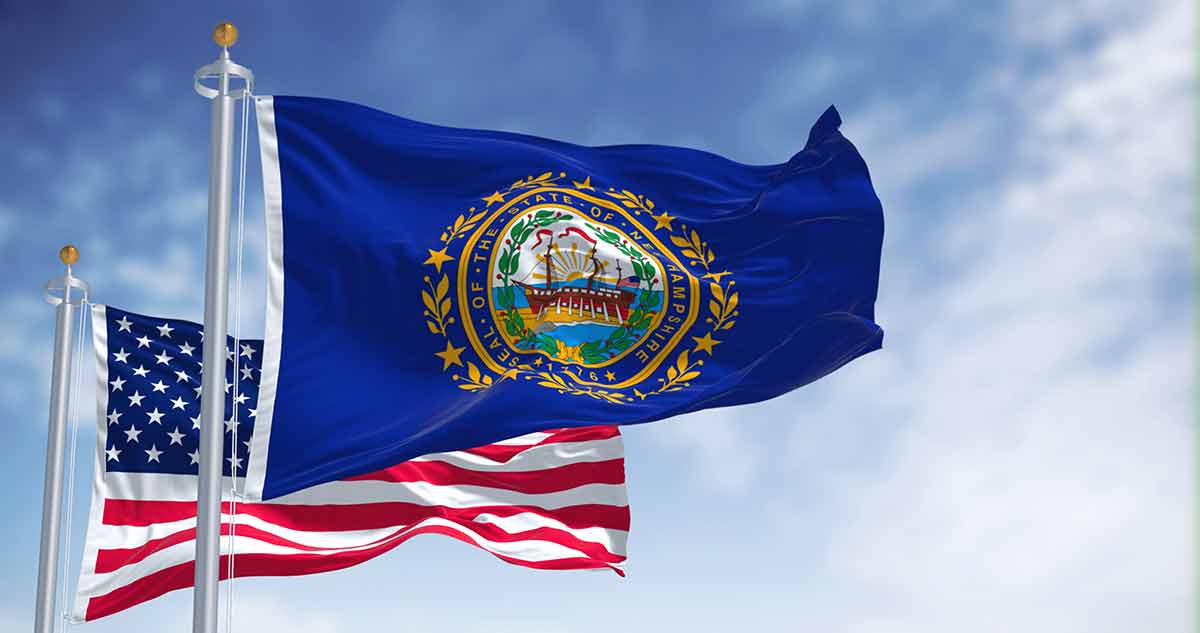
Seen on nearly every license plate in New Hampshire, the state’s ‘Live Free or Die’ motto holds deep meaning to its residents who fiercely defend their independence.
The phrase originated in 1809 from a letter written by General John Stark, a hero of the Revolutionary and French and Indian Wars.
Too ill to attend a meeting of veterans celebrating the 1777 Battle of Bennington, he wrote them a toast stating: ‘Live Free Or Die; Death Is Not The Worst Of Evils.’
Near the end of World War II, the legislature combined his famous words along with an image of the Old Man on the Mountain to form the state’s emblem, forever capturing a sentiment strongly held by the people of New Hampshire.
The phrase represents a deeper meaning throughout the United States. If you do not choose to live free, your rights, your freedoms, and your voice die. With great freedom, you must also have great courage and even greater responsibility.
14- Old Man On The Mountain
Discovered by settlers mapping a road in 1805, the Old Man of the Mountain was a granite rock formation on the side of Cannon Mountain which closely resembled the profile of an old man from the right angle.
The enormous stone face with a strong chiselled chin and eyebrows appeared to be stoically gazing over the White Mountains. Over time, his popularity grew among tourists exploring the Franconia Notch.
Sadly, this iconic symbol of the state collapsed in 2003 due to weathering and erosion caused by the freezing and thawing of water.
For nearly a century, dozens of people had attempted to preserve his legacy by anchoring the stone face to the mountain.
Just off Interstate 93 at Profile Plaza, you can learn more about their efforts and the history of the Old Man on the Mountain. There are also interactive exhibits that allow you to see what he would have looked like not that long ago.
15- Granite

From the peaks of the White Mountains to statues in almost every small town, you can find New Hampshire’s prized granite, almost everywhere.
As glaciers scraped across New Hampshire’s terrain during the last ice age, mountain tops were torn off by immense forces revealing its underlying beauty.
Boulders of granite that used to lie deep under the earth’s surface were scattered around the countryside and in the mountains.
Consisting of mainly quartz, feldspar, and mica, granite’s durability and strength make it an excellent choice for structures meant to stand the test of time.
Able to endure harsh winters like the people of the state, this light grey-coloured stone was heavily mined from quarries in New Hampshire, giving the state its nickname.
Other than monuments and bridges, granite is used indoors to create decorative countertops, floors, and stairs. New Hampshire’s granite can even be found in Washington, DC, where it was used to construct the Library of Congress.
You may also be interested in:
- What is Turkey known for?
- What is Portugal known for?
- What is Greece known for?
- What is France known for?
- What is Belgium known for?
- What is Switzerland known for?
- What is Poland known for?
- What is Australia known for?
- What is Mexico known for?
- What is Germany known for?
- What is Croatia known for?
- What is Hungary known for?
- What Is Romania known for?
- What is The Netherlands known for?
- What is Scotland known for?
- What is Canada known for?
- What is Japan known for?
- What is China known for?
- What is Singapore known for?
- What is Vietnam known for?
- What is Thailand known for?
- What is Cuba known for?
- What is Argentina known for?
- What is Colombia known for?
- What is Spain known for?
- What is Italy known for?
- What is Ireland known for?
- What is Oregon known for?
- What is Colorado known for?
- What is Tennessee known for?
- What is Hawaii known for?
- What is Alabama known for?
- What is Illinois known for?
- What is Mississippi known for?
- What is Nevada known for?
- What is Maine known for?
- What is Idaho known for?
- What is Delaware known for?
- What is Maryland known for?
- What is Wisconsin known for?
- What is Miami known for?
- What is Virginia known for?
- What is West Virginia known for?
- What is Massachusetts known for?
- What is Boston known for?
- What is Florida known for?
- What is Kentucky known for?
- What is Indiana known for?
- What is Montana known for?
- What is Nebraska known for?
- What is Pennsylvania known for?
- What is Vermont known for?
- What is Arizona known for?
- What is California known for?
- What is South Carolina known for?
- What is North Carolina known for?
- What is Texas known for?
- What is Michigan known for?
- What is Ohio known for?
- What is Louisiana known for?
- What is Oklahoma known for?
- What is New York known for?
- What is Georgia known for?
- What is Utah known for?
- What is Connecticut known for?
- What is Rhode Island known for?
- What is Iowa known for?
- What Is Minnesota known for?
- What is New Hampshire known for?
- What is Arkansas known for?
- What is New Jersey known for?
- What is Missouri known for?
- What is North Dakota known for?
- What is South Dakota known for?
- What is Wyoming known for?
- What is Alaska known for?
- What is Washington known for?
- What is Seattle known for?
- What is New Mexico known for?
- What is Kansas known for?
- What is San Francisco known for?
- What is Chicago known for?
- What is Denmark known for?
- What is Norway known for?
- What is Sweden known for?
Last update on 2024-07-25 / Affiliate links / Images from Amazon Product Advertising API
Plan Your Trip

Rent A Car – Find the best car rental rates at Discover Cars. They compare car hire companies to provide you with the best deal right now.

Find A Hotel – If you’re curious about this article and are looking for somewhere to stay, take a look at these amazing hotels.
